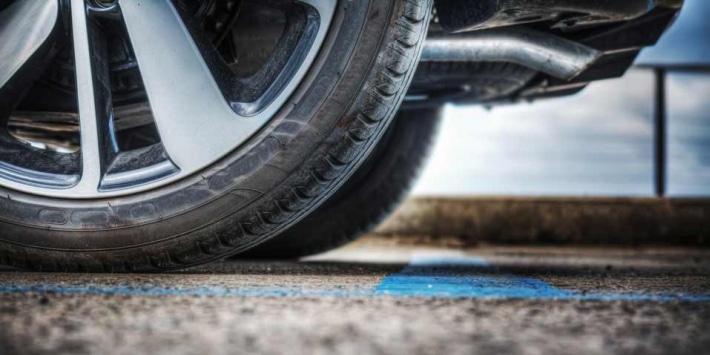Class A tyres for cars have a low rolling resistance. This is also noticeable in fuel consumption. In this practical tip, we explain why this is so and what is meant by the rolling resistance of tyres.
Rolling resistance of tyres
If you need new tyres for your car, their rolling resistance also comes into play. The EU tyre label, which is affixed to new tyres, should help you decide on a model. The label indicates and categorises criteria such as rolling resistance or fuel efficiency, wet grip and rolling noise. The rolling resistance of a tyre and its fuel consumption are interrelated. In general, the higher the rolling resistance of a tyre, the higher the fuel consumption of the car.
- Whether you like it or not, rubber tyres always have a rolling resistance. Because when the tyre moves, i.e. rolls, in order to move forward, it has to overcome resistance. In the process, it deforms constantly, but also returns to its typical shape in between. This is when the tyre’s casing relaxes again.
- During the driving process, the tread and the tyre sidewall are subjected to extreme stress and heat. The rubber compound and the tread of the car tyres are also decisive for its energy consumption. Heat is lost, which is lost as energy in the tyre.
- According to the ADAC, rolling resistance is defined as the force required for the rolling movement of the tyres. It is directly related to the wheel load. A high wheel load also causes the rolling resistance force to increase. Rolling resistance is measured and stated as a percentage in the form of the rolling resistance coefficient. This relates the rolling force to the wheel load.
- Tyre rolling resistance does not account for a small proportion of the general driving resistance of cars. It is proportionately around 20 percent when you are driving on the motorway. In urban traffic it is as much as 30 percent. This also means that around 25 percent of the fuel consumption of a car is caused by the tyres.
- This is due to the fact that the rolling resistance of the tyre counteracts the kinetic energy. Every time the vehicle accelerates, the rolling resistance must be overcome anew. So if you buy new car tyres with low rolling resistance, you can save a lot of fuel. Of course, this also improves your car’s emission values.
- The EU label gives energy efficiency classes from A to G when buying tyres. Class A tyres have the lowest possible resistance. Whereas those with a rolling resistance of E, F and G, on the other hand, have very high friction and therefore consume more fuel.
- However, fuel consumption also depends on the width of the tyre. In addition, the tread and the correct tyre pressure play a role. The correct tyre pressure reduces rolling resistance and thus saves fuel. To do this, consult your vehicle’s owner’s manual and check the pressure regularly.

“Eco” and “Energy” – models with reduced rolling resistance
There are already car tyres on the market with the additional designation “Energy” or “Eco”, which advertise lower rolling resistance. The tyre industry is working to optimise this further as well, by using new rubber compounds or changes in the construction of the tyre’s substructure. This should reduce energy absorption and the associated heating of the car tyre.
- Eco models are not yet as mature as conventional tyre models. Part of the problem is that eco-friendly, fuel-saving tyres have problems with wet and frost grip due to their lower rolling resistance. This is shown, for example, in the latest ADAC tyre tests.
-
Although wear is usually low and the low rolling resistance tyres save fuel, they do not always provide optimum wet grip on rainy roads. Thus, the braking distance of these tyres is longer on wet roads. Nevertheless, the eco-models, which are supposed to save fuel, perform solidly overall according to ADAC.
- With a tyre made of metal, you could neither brake well nor drive safely around bends. They also do not offer suspension characteristics like rubber tyres. These are also characterised by a wide tyre contact area. They have tread against aquaplaning and a springy air filling.
- From this you can see how important the overall properties of the tyre rubber are to the safety of driving. However, they also cost more in fuel due to the inevitable rolling resistance and heating.
Tyres without rolling resistance
Tyres without rolling resistance only exist in theory. These would be, for example, those that do not deform as a result of rolling, such as metal tyres. These have no rolling resistance. But these are not suitable for the demands of cars or trucks. They are much too heavy, rigid and immobile.

